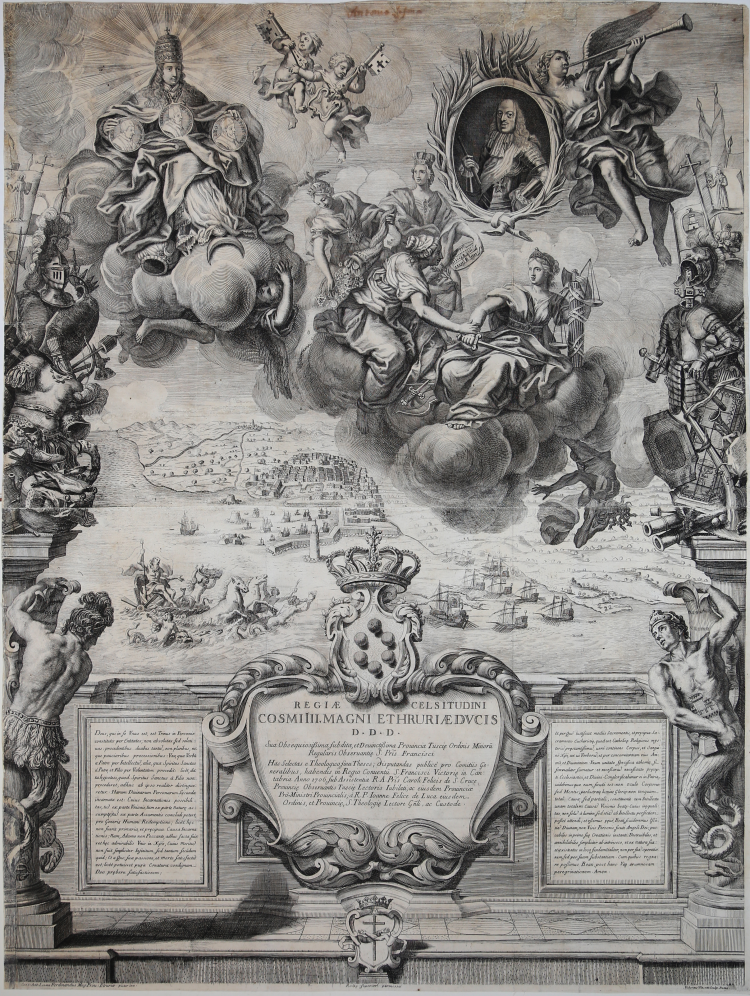



| Reference: | S42911 |
| Author | Hubert VINCENT |
| Year: | 1704 ca. |
| Zone: | Livorno |
| Measures: | 680 x 900 mm |


| Reference: | S42911 |
| Author | Hubert VINCENT |
| Year: | 1704 ca. |
| Zone: | Livorno |
| Measures: | 680 x 900 mm |
Etching and engraving, c. 1704, signed in plate at lower right. After a subject by Antonio Lesma.
Theological thesis of Giovanni Felice de Luca, discussed "sub assistentia" of Carlo Felice (born Ippolito) of Santa Croce sull'Arno; minor observant, uncle of the historian Giovanni Lami. The thesis is discussed in the convent of San Francisco de Vitoria in the Spanish region of Cantabria; demolished in 1930, the convent was believed to have been founded by St. Francis of Assisi in 1214.
It depicts an allegory of the victorious battles against the Turks, celebrating the exploits of the Order of the Knights of St. Stephen. The protagonists of the work, which was drawn by court painter Antonio Lesma and engraved in Rome by Hubert Vincent from Lyon, are Pope Clement XI, Cosimo III de Medici, and the cities of Pisa and Livorno, respectively the “head office” of the Order and the port from which the Knights embarked.
Pope Clement XI (Giovanni Francesco Albani, Urbino 1649 - Rome 1721) was the 243rd pope of the Catholic Church from 1700 until his death. Pope Albani is depicted in the upper right-hand corner above a cloud supported by an angel. He holds the effigies of Leo X, Clement VII and Leo XI; at his feet are the Turkish crescent and the Sultan's headdress, symbolising victory over the Muslim enemy.
Cosimo III de' Medici (Florence, 1642 - 1723), son of Ferdinando II de' Medici and Vittoria Della Rovere, was the penultimate Grand Duke of Tuscany belonging to the Medici dynasty. He is depicted in a scroll supported by an angel playing a trumpet, symbolising the allegory of Fame.
The Order of the Knights of St. Stephen was founded by Cosimo de' Medici in 1561 to ensure the defence of the Tuscan coast against pirates. In that historical context, the Mediterranean was unsafe due to Ottoman raids and it was Cosimo I's intention to create a network of fortified island outposts in the Mediterranean, of which the island of Elba would be the focal point to prevent Turkish assaults from reaching the heart of the Christian seignories. Cosimo had statutes drawn up in Florence similar to those of already existing Orders and in particular those of the Order of Malta, adopting the octagonal cross, but inverting the colours. The Order welcomed noble youth from all over Italy to Pisa, which, due to its maritime traditions, represented a centre worthy of respect for the memory of the great dominion it had had in the Mediterranean.
Hubert Vincent was born in Lyon but soon moved to Rome where he was active between 1680 and 1730 as an engraver of reproductions of paintings and frescoes, in particular of Raphael and Correggio. Vincent had already engraved in 1701 the plates for the famous I pregi della Toscana nell'imprese più segnalate de' cavalieri di Santo Stefano (The merits of Tuscany in the most noteworthy deeds of the Knights of St. Stephen), a work published by Fulvio Fontana of the Society of Jesus dedicated to the Royal Highness of Cosimo III Grand Duke of Tuscany and Grand Master of the Order, a collection that was printed to celebrate the glories of the Knights of St. Stephen. The 37 plates represent sieges and naval battles of the Tuscan fleet.
This panel re-proposes a model already used by Vincent in 1700, in a similar panel dedicated to the Viceroy of Naples Luis Francisco de la Cerda. The ornamental layout is the same; Pope Albani at the top left, the effigy of the dedicatee at the top right, the lateral ornamental frame with arms and armour, the cartouche with the dedication at the bottom, the perspective view - of Naples - in the background in the centre. Still unknown to repertories, the panel was in our possession in 2012 (cf. Cartografia Rara, cat. 45, Ed. Antiquarius, no. 55).
Although this Thesis bears the date 1706, the copperplate was probably engraved in 1704. In the bibliography Livorno nelle antiche stampe, by Piero Frati, the work is illustrated with variants; in the cartouches at the bottom, with three sheets of typographic text applied above the engraved part, we find Zenobio Zagrio's dedication to Cosimo III, accompanied by the title THESES PHILOSOPHICAE and with imprint Florentiae MDCCIV apud Michelem Nestum.
Magnificent proof, rich in tone, printed on two large sheets of contemporary laid virgin paper, trimmed in copperplate, restoration in the lower and upper left-hand corner, paper creases visible on the verso, otherwise in excellent condition.
A very rare work, known so far only for the variant in the Piero Frati collection.
Bibliografia
Cfr. Piero Frati, Livorno nelle antiche stampe, 2000, p. 64, n. 40.
Hubert VINCENT (attivo a Roma tra il 1680 – 1730)
|
Hubert Vincent was born in Lyon but soon moved to Rome where he was active between 1680 and 1730 as an engraver of reproductions of paintings and frescoes, particularly of Raphael and Correggio.
|
Hubert VINCENT (attivo a Roma tra il 1680 – 1730)
|
Hubert Vincent was born in Lyon but soon moved to Rome where he was active between 1680 and 1730 as an engraver of reproductions of paintings and frescoes, particularly of Raphael and Correggio.
|